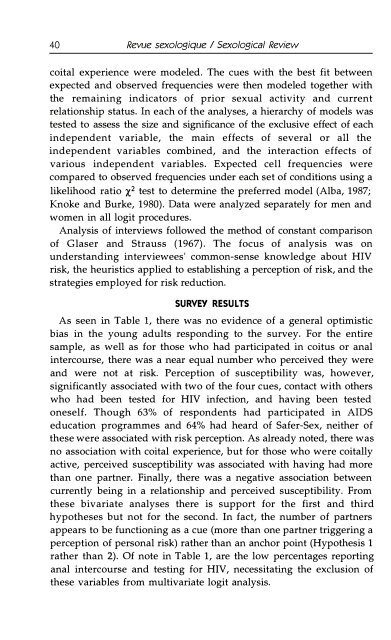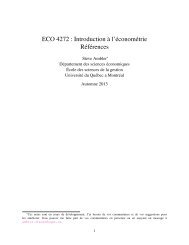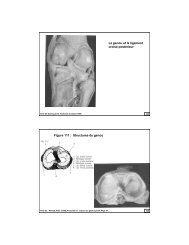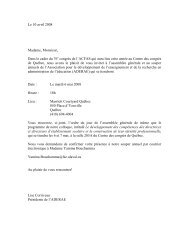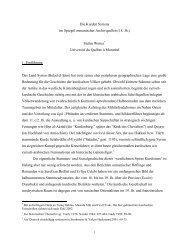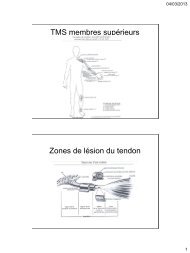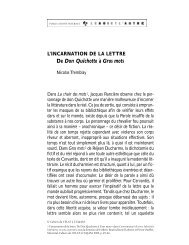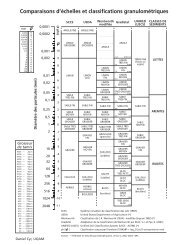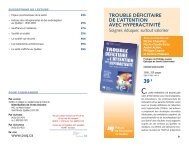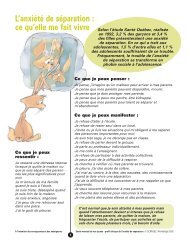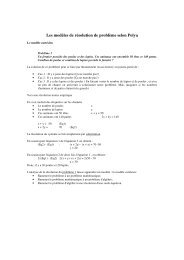Télécharger la revue en format "pdf". - UQAM
Télécharger la revue en format "pdf". - UQAM
Télécharger la revue en format "pdf". - UQAM
You also want an ePaper? Increase the reach of your titles
YUMPU automatically turns print PDFs into web optimized ePapers that Google loves.
40 Revue sexologique / Sexological Review<br />
coital experi<strong>en</strong>ce were modeled. The cues with the best fit betwe<strong>en</strong><br />
expected and observed frequ<strong>en</strong>cies were th<strong>en</strong> modeled together with<br />
the remaining indicators of prior sexual activity and curr<strong>en</strong>t<br />
re<strong>la</strong>tionship status. In each of the analyses, a hierarchy of models was<br />
tested to assess the size and significance of the exclusive effec of each<br />
indep<strong>en</strong>d<strong>en</strong>t variable, the main effects of several or aIl the<br />
indep<strong>en</strong>d<strong>en</strong>t variables combined, and the interaction effects of<br />
various indep<strong>en</strong>d<strong>en</strong>t variables. Expected ceIl frequ<strong>en</strong>cies were<br />
compared to observed frequ<strong>en</strong>cies under each set of conditions using a<br />
likelihood ratio X2 test to determine the preferred model (Alba, 1987;<br />
Knoke and Burke, 1980). Data were analyzed separately for m<strong>en</strong> and<br />
wom<strong>en</strong> in all logit procedures.<br />
Analysis of interviews followed the method of constant comparison<br />
of G<strong>la</strong>ser and Strauss (1967). The focus of analysis was on<br />
understanding interviewees' common-s<strong>en</strong>se knowledge about HIV<br />
risk, the heuristics applied to establishing a perception of risk, and the<br />
strategies employed for risk reduction.<br />
SURVEY RESULTS<br />
As se<strong>en</strong> i Table 1, there was no evid<strong>en</strong>ce of a g<strong>en</strong>eral optimistic<br />
bias in the young adults responding to the survey. For the <strong>en</strong> tire<br />
sample, as wel1 as for those who had participated in coitus or anal<br />
intercourse, there was a near equal number who perceived they were<br />
and were not at risk. Perception of susceptibility was, however,<br />
significantly associated with two of the four cues, contact with others<br />
who had be<strong>en</strong> tested for HIV infection, and having be<strong>en</strong> tested<br />
oneself. Though 63% of respond<strong>en</strong>ts had participated in AIDS<br />
education programmes and 64% had heard of Safer-Sex, neither of<br />
these were associated with risk perception. As already noted, there was<br />
no association with coital experi<strong>en</strong>ce, but for those who were coitally<br />
active, perceived susceptibility was associated with having had more<br />
than one partner. Finally, there was a negative association betwe<strong>en</strong><br />
curr<strong>en</strong>tly being in a re<strong>la</strong>tionship and perceived susceptibility. From<br />
these bivariate analyses there is support for the first and third<br />
hypotheses but not for the second. In fact, the number of partners<br />
appears to be functioning as a cue (more than one partner triggering a<br />
perception of personal risk) rather than an anchor point (Hypothesis 1<br />
rather than 2). Of note in Table 1, are the low perc<strong>en</strong>tages reporting<br />
anal intercourse and testing for HIV, necessitating the exclusion of<br />
these variables from multivariate logit analysis.


